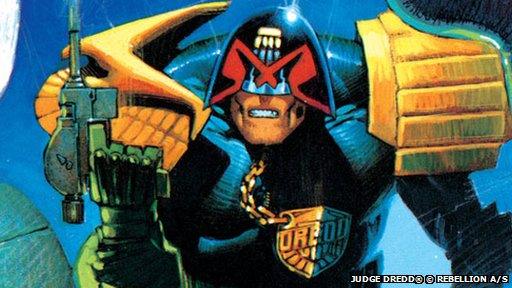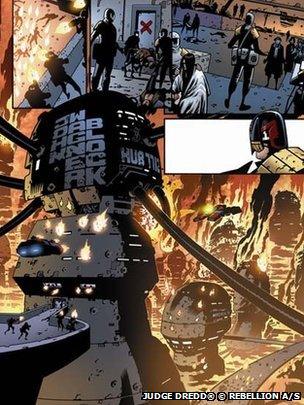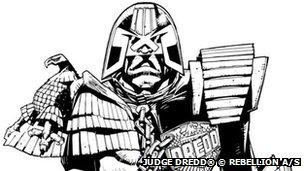Scotland's influence on 2000AD's Judge Dredd
- Published

Artwork of Judge Dredd by Fort William-born Colin MacNeil
Dredd 3D opens in cinemas in September. It draws on 2000AD's Judge Dredd strips that have gripped fans for almost 40 years - and which have been shaped by Scots.
An injustice many years ago still sticks in the mind of John Wagner, the US-born and Greenock-raised co-creator of futuristic law enforcer Dredd.
During a short break from comic strip writing early on in his career, Wagner took a job in the Scottish Highlands.
He said: "I was the caretaker of a mansion.
"I have so many memories from that time, but I suppose the outstanding one is being asked to leave after persons unknown stripped the roof of lead."
Returning to writing, Wagner went on to create Dredd with Spanish artist Carlos Ezquerra.
What emerged from their imaginations was a character who, in real life, would have sent the mansion's lead thieves running for the hills fearing for their lives.
Set in the 22nd Century, Dredd and his fellow enforcers act as judge, jury and executioner in Mega-City One - a sprawling North American metropolis of 400 million inhabitants.
Beyond Mega-City One's massive walls is the Cursed Earth where mutants scratch out a living on the radioactive wasteland left in the aftermath of a nuclear war.
In a BBC interview in 2002, Wagner said he had become a bit more optimistic about the future.
But 10 years on, he said: "I'm not sure when I had that change of heart.
"Must have been pretty brief. I still think we're well on course for destruction."
Wagner moved from the US to Scotland when he was 12 and went on to work for Dundee publisher DC Thomson.
Later, during a spell as a freelance, he worked with Pat Mills, who went on to become a legendary Dredd writer, from a shed at Mills' home in Fife.
On how much of Scotland features in Dredd's DNA, Wagner said: "Well, he's pretty dour, but apart from that I can't make a particularly Scottish connection."
Veteran Dredd artist Cam Kennedy reckons Scottish humour has crept into the stories.
Orkney-based Kennedy regularly worked with Wagner and writer Alan Grant, another Scot.
Kennedy said: "We all have the same sense of humour.
"Many times I would come off the phone after talking to John, or Alan, and my face was aching from laughing so much.
"There was a story, not a Judge Dredd one, that I worked on for Marvel.
"It was a story about a character called Nick Fury and he had come to Bonnie Scotland to fight terrorists who had a base at the top of Orkney's Old Man of Hoy.
"We had a good laugh about that one, knowing that the top of the Old Man of Hoy really is not all that big."
An encounter with a legendary US writer at DC Comics, Marvel's arch-rival comic publisher, led to Kennedy inspiring a character in Dredd.
Wagner and Grant had pitched a story idea to DC Comics, which Kennedy would draw.
After initial keen interest, Kennedy said that the trio struggled to get confirmation that the strip was going ahead.
Kennedy said: "This was in the 80s when you had to try and reach people by phone. You couldn't text or email someone directly.
"Eventually it was decided one of us should go to New York and confront Denny O'Neil, a writer and editor mainly of Batman stories, about our pitch.

Judge Dredd is the law in sprawling, overcrowded Mega-City One
"It was me - the one furthest from the main airports and who had to take a ferry and then drive to Glasgow - who was picked to go.
"When I finally got to DC Comics, I was pointed down a corridor to O'Neil's office. This guy with braces holding up his troosers came out of the office just before I reached it.
"I asked him if he was Denny O'Neil and then told him I was Cam Kennedy from Scotland. He just looked at me and said "Kenny Who?"
Greatly amused, Wagner and Grant went on to write Kenny Who? as a character. In one strip, he travels to Mega-City One from the Caledonian Hab Zone (Calhab) in Scotland.
Kennedy said: "Kenny Who? ends up in jail and his wife and two kids then come over and confront Dredd. One of Kenny's kids pees on Dredd."
Kennedy's depictions of Mega-City One in the story The Midnight Surfer earned him critical acclaim.
The artist, whose craft has since been affected by an eye disease, said: "People still request drawings from The Midnight Surfer.
"But I haven't been able to find any and I don't think I've sold them all.
"Not being able to find them is a real regret."
Billy Connolly
As a boy growing up in Inverness in the 1970s, Fort William-born artist Colin MacNeil was wowed by the stories and their artwork.
The last page of the second issue of 2000AD made a big impression on the young MacNeil.
He said: "There was a splash panel showing Mega-City One.
"This idea of an über urban environment with buildings rising a mile high into the sky was almost inconceivable."
Interested in drawing from a young age, MacNeil won national art competitions run by the Boys' Brigade and also a contest to design a logo for Inverness's Eastgate Shopping Centre to mark its opening.

Scots writers and artists continue to work on Judge Dredd stories
After leaving school he studied art in Aberdeen and later Dundee, where he juggled his course work with commissions from 2000AD.
He first provided art for the comic's Future Shocks short stories, before landing his dream gig in 1987 drawing Dredd strips.
Now living in Galashiels, MacNeil continues to work on Dredd, including the recent Day of Chaos.
The artist said: "I love Dredd. It is the entire package - him, the other characters and Mega-City One.
"But as much as I am fascinated by that city I have no desire to live in one.
"I grew up walking in the hills with my father and I still live in the countryside. I prefer the green to the grey."
'Scottish weather'
Jim Alexander, who was brought up in Ardrossan in Ayrshire, wrote Calhab Justice - which is set in the Dredd universe - in the 1990s.
It tells of futuristic Scottish clans stealing back the Stone of Destiny. The story's main judge is Ed MacBrayne, pitched originally by Alexander as a cross between Judge Dredd and Billy Connolly.
Alexander said Scots comic writers and artists found themselves drawn to Dredd.
He said: "I think we can give or take Dredd and the fascist pro-authority figure at least on the face of it he represents.
"There is humour to be had of course, but we don't shirk away from the stark choices judges have to make in a place like Mega-City One. Tough moral and political decisions are explored in an exciting, funny and invariably very violent way.
"I think the mind of the Scottish writer is perfectly adjusted to juggling all these balls and keeping them up in the air as long as possible."
He added: "Oh, and there's also the terrible Scottish weather to keep you indoors and help cultivate those dank, dark, unholy thoughts."
- Published2 February 2012